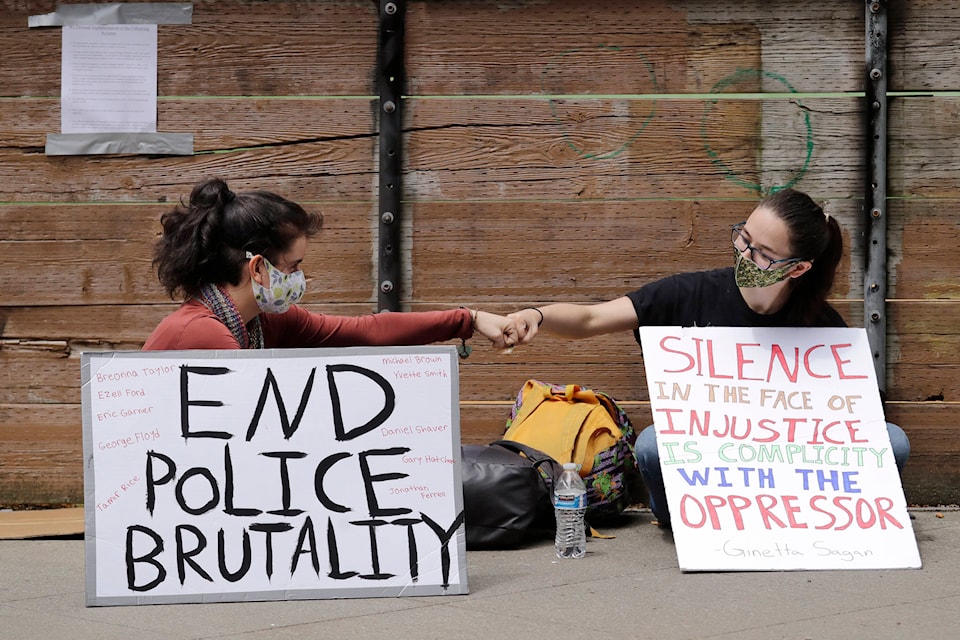WASHINGTON — The outraged Americans flooding the national capital this weekend will be greeted by two oversized, street-level reactions to the country’s latest historic flashpoint — a study in political contrasts built by separate work crews.
“Black Lives Matter” — block letters as tall as the roadway is wide, stencilled by city workers in yellow traffic paint — jumps off the asphalt along the two blocks of 16th Street leading to Lafayette Square, ending just before the pastel walls of the boarded-up St. John’s Episcopal Church.
Just across H Street, meanwhile, a two-metre black steel fence, initially erected to keep protesters out of the park, was being extended and fortified late Friday to encapsulate the entire White House complex and adjacent buildings, with contractors installing concrete barriers for good measure.
By all accounts, both the protesters and the perimeter will be there for a while.
“We’ll be out here for as long as it takes — as long as it takes,” said Adele McClure, 31, a lifelong social activist and executive director of the Virginia Legislative Black Caucus.
Even from behind her white cloth face mask, adorned with the words “Stop Killing Us” in black marker, McClure’s frustration and determination was clear as she spelled out her reasons for persisting.
“We’re tired, we’re angry … Every single time we see a murder, we see our brothers, we see our uncles, we see our fathers — we see everybody in those murders. So we’re done,” she yelled, straining to be heard over the gospel music blasting from a nearby amplifier.
It’s not just police brutality, McClure added — deep-seated institutional racism has deep roots in the U.S., and has been holding back African-American communities and other people of colour for centuries.
“As long as it takes, we’re going to continue to put the pressure on and make sure that we fix and dismantle these systems.”
Protesters have been clogging city streets for more than a week, moved to action by the death of Floyd at the hands of police officers May 25 on a Minneapolis street. And while the violence and looting that marred the earliest days of the protests has diminished, their numbers have not.
Hundreds more turned out Friday, many with kids in tow, to check out the striking pavement mural ordered by D.C. Mayor Muriel Bowser.
“There’s a lot of anger, there’s a lot of distrust of police and the government, there are people who are craving to be heard and to be seen and to have their humanity recognized,” Bowser said Friday.
“That message is to the American people, that black lives matter, that black humanity matters, and we as a city raise that up, as part of our values as a city.”
Floyd spent the last eight minutes of his life lying on the pavement, the knee of former Minneapolis police officer Derek Chauvin pressing into his neck, after being arrested for allegedly trying to use a counterfeit $20 bill.
Chauvin now faces a charge of second-degree murder and manslaughter, while the other three ex-officers involved — Thomas Lane and J. Alexander Kueng helped restrain Floyd, while Tou Thao stood nearby — are charged with aiding and abetting the murder and manslaughter counts.
Those upgraded charges, along with a cathartic memorial service Thursday featuring the famously combative black activist Rev. Al Sharpton, have done little to salve the palpable sense of public anger and impatience.
“We anticipate numbers that are larger than any of the numbers we have seen to this point,” D.C. police Chief Peter Newsham told a news conference Friday.
He likened the potential turnout to the Women’s March of 2017, the day after President Donald Trump’s inauguration, which by some accounts attracted a million people. Still, he doesn’t expect a turnout that large, Newsham noted, because similar events are taking place all across the U.S.
“The critical thing for us in ensuring the city is safe when we have large gatherings, outside of the public health issue, is to ensure that we don’t have people who are inclined to engage in bad behaviour.”
McClure’s mother said she’s confident it won’t come to that.
“I’m praying that with the Lord’s will, that this will make a difference,” she said.
“I’m just praying that with all the people, all the different races and nationalities out here, that we can make a positive impact. And peacefully.”
